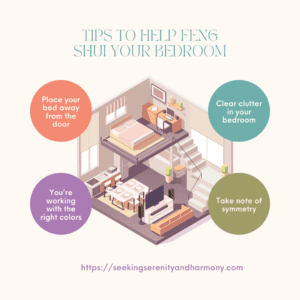Feng Shui Your Bedroom
How to feng shui your bedroom

Feng shui is the ancient Chinese practice of using spatial arrangement and orientation to produce harmonious spaces.
In historic and modern China, we can find feng shui in architecture, tombs, the placement of statues, and much more. However, it’s in interior spaces where feng shui is most evident worldwide.
Feng shui is known as the art of placement, but it’s just as important to recognise the meaning behind the arrangement – harmony. Feng shui has balance and positive energy, or chi, creating a connection between you and the space.
This article explores how to introduce feng shui to your bedroom.

Embrace the five elements
Feng shui divides the world into five elements: wood, fire, earth, metal, and water, and your bedroom should incorporate all these elements for balance.
For example, you could have:
- A wooden bed
- Candles (fire)
- Plants (earth)
- Metal sculptures
- An aquarium (water)
If your bedroom feels as though it is missing something, you can refer to these five elements and see if you are light in any of them.
Feng shui colours
The following colours are feng shui:
- Off-white
- Cream
- Peach
- Beige
- Lilac
- Woody green
The tones are always muted in feng shui, but pops of colours are allowed – you can add orange, bright yellow, and other shades in moderation. Keep things light, and make sure at least 70% of your bedroom is neutral.

Create proportion
Proportion is the key to feng shui, and the good news is that you have the perfect focal point to work around – your bed.
Your bed sets the eye level of your bedroom, so it dictates how tall and wide your furniture should be. Chests, tables, and desks should be only a foot higher than your bed or two feet higher if you have a low bed.
Look for ways to slimline furniture and save space, so your bed commands attention and draws the eye.
Pairs and pairings
Symmetry is a massive part of feng shui because it creates balance, and the easiest way to achieve it is by buying things in pairs.
For example, you can buy the following:
- Two of the same lamps
- Two of the same vases
- Two of the same chairs
- Two of the same cushions
Look for ways to buy in pairs to promote harmonious energy – mismatched items will only disrupt the flow of your bedroom.
Wall Tapestry
While most interior designs call for paintings, wire art, or other traditional wall art, feng shui works best with a tapestry.
Wall tapestry creates the illusion of a larger space and decorates walls in a light, free-flowing way. Tapestry depicting mountains, the night sky, the tree of life, or yin and yang will give your bedroom feng shui vibes.
Introduce nature
Feng shui is based on the natural landscape, where plants, wildlife, and humans coexist, so greenery is an essential part of feng shui design.
We recommend one large plant in the corner of your bedroom, like a Yucca, Dragon Tree, Kentia Palm, Snake Plant, or Ficus, for bonsai vibes. Add a bonsai tree to your windowsill to create natural harmony in your bedroom.
Play with your bedroom layout
The most overlooked aspect of feng shui interior design is flow – how a space feels to use and how you navigate it.
Your bed should be easy to access, and the route to the door should be unimpeded by things like washing baskets and desks.
Look for ways to increase floor space and open your bedroom up so you have more living area to enjoy. Less is more!
Summing up
Feng shui isn’t an interior design – it’s a movement. You can add feng shui to any interior style, but it works best with Scandinavian, modern, and industrial designs. Look for ways to harmonise your bedroom, and you will feel happier in it.
If you enjoyed this article, read our article on creating an aesthetically pleasing bedroom.